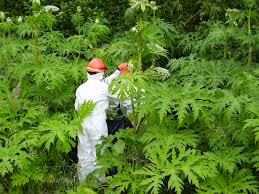Heracleum mantegazzianum-Giant Hogweed is a perennial plant and a member of the carrot family. It is a garden ornamental from southwest Asia that is naturalizing in North America and becoming more common in southern and central Ontario. Giant Hogweed has the potential to spread readily and grows along roadsides, ditches and streams. It invades old fields and native habitats such as open woodlands.
Caution: Giant
Hogweed is a dangerous weed. Its leaves and stem contain a clear, watery sap
that is highly toxic. If you get any of this weed’s sap on your skin, you will
notice the following symptoms within 48 hours:
·
Blisters
·
Burns
·
Possible scarring
·
Hypersensitivity to sunlight
What Giant Hogweed Looks Like:
Giant
hogweed certainly lives up to its name, growing 3 to 4 metres in height and
when in bloom, carries numerous small, white flowers that form an umbrella
shape. It looks like a colossal version of Queen Anne's lace, or wild carrot
and is often mistaken for angelica or cow parsnip because of its similar leaf
pattern. Giant hogweed is most commonly recognised by its flowering stalks, the
plant blooms in mid-May through July.
1.
Giant hogweed has a stout, bright green
stem that is frequently spotted with dark red and hollow red-spotted leaf
stalks that produce sturdy bristles.
2.
The stems grow to more than 2 m high. The
hollow stems vary from 3–8 cm (1.2–3.1 in) in diameter, occasionally up to 10
cm (3.9 in).
3.
Each dark red spot on the stem surrounds a
hair, and large, coarse white hairs occur at the base of the leaf stalk.
4.
The plant has deeply incised compound
leaves which grow up to 1–1.7 m (3 ft 3 in–5 ft 7 in) in width.
5.
Giant hogweed is a biennial or monocarpic
perennial, [7]:827 the plants usually begin dying after they have set seed.
6.
It
usually flowers in its second year from late spring to midsummer, with numerous
white flowers clustered in an umbrella-shaped head that is up to 80 cm (31 in)
in diameter across its flat top.
7.
The plant produces 1,500 to 100,000
flattened, 1-centimetre (0.39 in)-long, oval, dry seeds that have a broadly
rounded base and broad marginal ridges. Tall dead stems may mark its locations
during winter.
If you find the plant in your
backyard, the City of Vancouver British Columbia recommends removing it. The
weed is a public health hazard and is dangerous to both children and pets.
How to Get Rid Of Giant Hogweed:
Wear heavy, water-proof gloves, and
water-proof coveralls or clothing that leaves no skin exposed.
Wear eye protection.
Remove lower branches to clear a safe
path to the main stem.
Remove flower heads when main stem is
clear to prevent seed growth and dispersal.
Use a sharp shovel to sever the plant
taproot 8 to 12 cm below the surface of the soil.
Put the plant (all leaves, stem and head)
in a doubled up garbage bag.
Put the doubled up garbage bag in the
garbage.
Do not put giant hogweed in your Green
Bin or backyard composter.
What to do if you come in contact with
giant hogweed
If You Accidentally Come In
Contact With Giant Hogweed Sap, You Should:
Wash the exposed area carefully with soap
and water.
Keep the area away from sunlight for at
least 48 hours.
Consult a doctor if a rash or blisters
develop.
Remember; while there are a number of *safe*plants that look very similar to Giant hogweed such as Cow
parsnip, Purple stem angelica, Woodland angelica, Valerian, Lavage, and Queen
Anne’s-Lace (also known as Wild carrot). However, unless you are absolutely
sure; it’s just not worth taking a chance. The “safe “plants are not as large as a mature Giant hogweed, which
grows up to 5.5 metres tall under ideal conditions. The white flower clusters of
Giant hogweed resemble those of Queen Anne’s-Lace, but tend to be more widely
spaced and can form a flower-head almost one metre wide.











